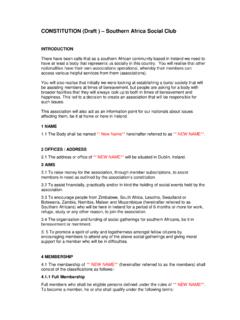Transcription of A quick reference for convening conversations …
1 Hosting in a hurry v the Art of Hosting into practiceA quick reference for convening conversations that conversations are opportunities for us to connect a little deeper with one another. In the Art of Hosting practice we often talk of the four fold way and the seven little helpers: the simplest tools for convening any far most of the conversations we host in our lives at work or in the community are conversations with small groups. These simple processes are offered as quick reference for bringing depth and life to those conversations . The Four Fold Way of HostingWe have learned that quality conversations leading to close team work and wise action arise when there are four conditions present. 1. Be Present 2.
2 Participate and practice conversations3. Host 4. Co-createWe call these four conditions the Four Fold Way of Hosting, because you can practice these any time. They form the basis for all good Present ..host yourself first - be willing to sit in the chaos - keep the space open - sit in the fire of the present means showing up, undistracted, prepared, clear about the need and what your personal contribution can be. It allows you to check in with yourself and develop the personal practice of curiosity about the outcomes of any gathering. Presence means making space to devote a dedicated time to working with others. If you are distracted, called out or otherwise located in many different places, you cannot be present in one.
3 For meetings to have deep results, every person in the room should be fully present. Collectively, it is good practice to become present together as a meeting begins This might be as simple as taking a moment of silence to rest into the present. If an Elder is present, a prayer does this very nicely. Invite a collective slowing down so that all participants in a meeting can be present to help you become presentWhat am I curious about?Where am I feeling anxiety coming into this meeting and how can I let that go?What clarity do I need? What clarity do I have?Participate and practice willing to listen fully, respectfully, without judgement and thinking you already know all the answer practice conversation is an art, it is not just talk.
4 It demands that we listen carefully to one another and that we offer what we can in the service of the whole. Curiosity and judgement cannot live together in the same space. If we are judging what we are hearing, we cannot be curious about the outcome, and if we have called a meeting because we are uncertain of the way forward, being open is a key skill and capacity. Only by practising skilful conversation can we find our best practice we practice conversation mindfully we might slow down meetings so that wisdom and clarity can work quickly. When we talk mindlessly, we don't allow space for the clarity to arise. The art of conversation is the art of slowing down to speed courageous, inviting and willing to initiate conversations that matter - find and host powerful questions with the stakeholders and then make sure you harvest the answers, the patterns, insights learnings and wise conversations is both more and less than facilitating.
5 It means taking responsibility for creating and holding the container in which a group of people can do their best work together. You can create this container using the seven helpers as starting points, and although you can also do this in the moment, the more preparation you have the better. The bare minimum to do is to discern the need, prepare a question and know what you will do with the harvest. If there is no need to meet, don't meet. If there is a need get clear on the need and prepare a process that will meet that need by asking a powerful question. And always know how you will harvest and what will be done with that harvest, to ensure that results are sustainable and the effort was worth it. Hosting conversations takes courage and it takes a bit of certainty and faith in your people.
6 We sometimes give short shrift to conversational spaces because of the fear we experience in stepping up to host. It is, however, a gift to host a group and it is a gift to be hosted well. Work in meetings becomes that much conversation Listen and help others to listenUse silenceContribute to the harvestPut good questions in the centreConnect ideas Hosting basicsDetermine the need and the purposeCreate a powerful questionHost an appropriate processEncourage willing to co create and co-host with others, blending your knowing, experience and practices with theirs, working fourth practice is about showing up in a conversation without being a spectator, and contributing to the collective effort to sustain results.
7 The best conversations arise when we listen for what is in the middle, what is arising out of the centre of our collaboration. It is not about the balancing of individual agendas, it is about finding out what is new. And when that is discovered work unfolds beautifully when everyone is clear about what they can contribute to the work. This is how results become sustainable over time they fall into the network of relationships that arise from a good conversation, from friends working together. So contribute what you know to the mix so that patterns may become clear and the collaborative field can produce unexpected and surprising results. 4Co-creation Speak truthSpeak for what is in the middleOffer what you canAsk for what you needCommit to what you can Let go The Seven HelpersOver the years, we have identified seven little tools that are the source of good conversational design.
8 At the bare minimum, if you use these tools, conversations will grow deeper and work will occur at a more meaningful level. These seven helpers bring form to fear and uncertainty and help us stay in the chaos of not knowing the answers. They help us to move through uncomfortable places together, like conflict, uncertainty, fear and the groan zone and to arrive at wise a good a talking a wise together1. Be PresentInviting presence is a core practice of hosting, but it is also a key practice for laying the ground work for a good meeting. There are many ways of bringing a group to presence, including: Start with a prayer Start with a moment of silence Check in with a personal question related to the theme of the meeting Pass a talking piece and provide space for each voice to be heardStart well.
9 Start slowly. Check everyone Have a good questionA good question is aligned with the need and purpose of the meeting and invites us to go to another level. Good questions are put into the centre of a circle and the group speaks through them. Having a powerful question at the centre keeps the focus on the work and helps a groups stay away from unhelpful behaviours like personal attacks, politics and closed minds. A good question has the following characteristics: Is simple and clear Is thought provoking Generates energy Focuses inquiry Challenges assumptions Opens new possibilities Evokes more questionsIt is wise to design these questions beforehand and make them essential pieces of the invitation for others to join you.
10 As you dive into these questions, harvest the new questions that are arising. They represent the path you need to Use a talking pieceIn it's simplest form a talking piece is simply and object that passes from hand to hand. When one is holding the piece, one is invited to speak and everyone is invited to listen. Using a talking piece has the powerful effect of ensuring that every voice is heard and it sharpens both speech and listening. It slows down a conversation so that when things are moving too fast, or people begin speaking over one another and the listening stops, a talking piece restores calm and smoothness. Conducting the opening round of a conversation with a talking piece sets the tone for the meeting and helps people to remember the power of this simple course a talking piece is really a minimal form of structure.








